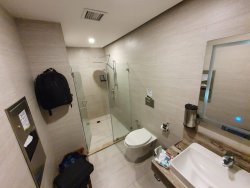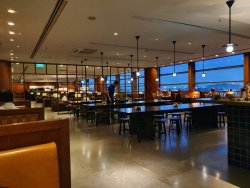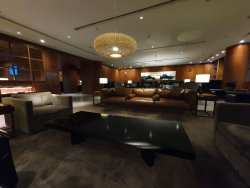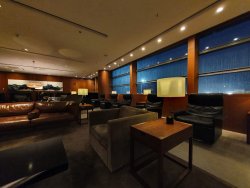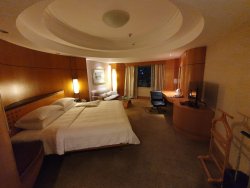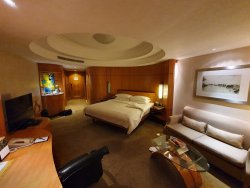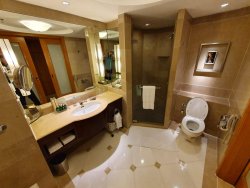For a MNL stopover, choose your airline carefully as the immigration queues in T1 and T3 tend to be more than PR's T2, although as for most worldwide airports, highly variable. I have always found BKK worse than MNL, so it's all relative.
Compared with a few years ago, there's been a big jump in the number of nonstop flights to Manila.
Manila has more annual passengers than Melbourne (with a far higher percentage international travellers) but super crowded airspace. Manila NAIA is operating beyond its rated capacity. There are only two runways and at most the airport seems to be able to handle about 41 movements per hour, very low. During many days delays increase during the early afternoon. There can be insufficient gates at T3 so many 5J and (of those that use T3) PR domestic flights see passengers bussed, which slows operations down as it does anywhere else.
PR uses its redone A333s (1-2-1 in J lie flat) ex Melbourne daily, but from SYD and BNE (respectively nine and five flights each way per week), it's normally the smaller A321s (2-2 lie flat in J). Possibly over Christmas school holidays when demand hugely peaks to and from Philippines, there's a chance we may again see one of these refurbished A333s flying to and from SYD. PR seems to change its mind with regularity.
5J flies five days a week ex SYD and three afternoons a week ex MEL, while QF flies daily ex SYD. There's far more competition on fares than a decade ago and with PR and sometimes 5J, fares to non-Filipino destinations can also be good value, so MNL is gradually attracting more connecting passengers.
Z2 (Philippines AirAsia) also has a reasonably extensive domestic Filipino network and some international routes, but, following the advice of AFFer job747 (which was specifically re AirAsiaX if I recall) I try not to fly on Z2 as its pilots don't appear to be as experienced as on PR or even 5J.
T6 (AirSWIFT) is owned by what many consider Philippines' best company, Ayala (famous for high quality shopping and increasingly apartments) and provides a link between MNL and the resort area of El Nido on Palawan Island, including nonstop transport to close to Ayala's over-water bungalows at its resorts like Miniloc. I haven't travelled on it but know some who have: all said at the minimum it was very good. T6 now departs from the smallest terminal, T4, that only has a smattering of domestic flights.
AO (Air Juan) is a relatively new player and has flights from MNL, CEB and PPS. It can get you to some destinations not served by PR or 5J. I have not used it but it gets good reviews.
There is a complete lack of nonstop flights between Australia and Cebu's Mactan Island International Airport with its new T2, very airy and attractive (though not large) for international. These could serve about 40 per cent of the 107 million population who live in Visayas or Mindanao, but so far (probably due to perceived low yields plus difficulty of filling aircraft at acceptable fares to the airline) no carrier has done this. Cebu's airport has had a big rise in annual passenger journeys.
Mactan Airport has what might be a 30 plus year old hotel at the airport run by the strangely named Waterfront Hotels (none of its hotels are at the sea in Cebu or Manila). It was very good. Like the Parkroyal at MEL or especially excellent Rydges at SYDi, it's possible if on a higher floor to watch aircraft arriving and departing. Mactan has a good number of Asian carriers that don't fly to Australia but which have expended to Philippines in the last two or three years.
Davao City, further south in Mindanao is a growing airport. It has limited international links. I suspect some of these that have commenced may not be sustainable. Time will tell.
I prefer PR as it uses more modern aircraft than QF ex Oz and also has a good safety record, and friendlier staff.
PR's T2 international airside Mabuhay Miles lounge is poor despite having been renovated in the last five years. There is one shower. It didn't renovate the toilets, which retain that old style marble look (I'm not a fan). The range of food available is poor, especially if one doesn't like the rice porridge arroz caldo. Drinks have an acceptable range, but to further compensate at least PR serves an excellent brand of champagne on board in J for those who imbibe that.
There are some newish airside lounges in T3 plus pods for overnight accommdoation (airside) while T1 recently underwent cosmetic renovations that have made it look a lot better, and operate somewhat better.
T3 has an excellent number (and range) of food outlets on the landside, up at mezzanine level. They can be very busy with families marking departure of a loved one Unlike pricey Australia, one doesn't seem to pay much more at these airport cafes and restaurants. Service is typically Filipino-friendly, but keep an eye on the clock and allow plenty of time for immigration, just as one would at the former IST or some LHR terminals.
T1 has a barely acceptable offering (airside) while T2 is by far the worst: no restaurant that I've ever seen, a sterile atmosphere and not even a decent cafe. Very poor considering the investment PR has made in its new aircraft such as A359s and how it's refurbished a majority of its A333s, plus brought A321neos with flat beds in J into operation.
Filipinos are extremely friendly and hospitable and usually MNL is extremely safe despite what one may have read over the years. No AFFer is stupid enough to agree to a game of poker at a 'new friend's' house.
My number one tip is to minimise the distance you travel from the Manila NAIA airport if on a brief stopover, because of what can be horrendously slow road travel. In SE or NE Asia, only Jakarta is worse.
My number two suggestion is to change money at an airport bank (generally just outside the airport exit but in T3 on arrivals level) and make sure you receive some small notes as a problem in Philippines is that shops and taxis alike routinely claim they lack change.
The only areas to consider staying in are:
Roxas Boulevard/Ermita/Malate/Manila Bay
Pasay City
Entertainment City (reclaimed land)
Newport City (opposite T3 and connected by a walkway called Manila Runway: there are a number of airport hotels, including two or three that opened in 2018 or 2019)
Makati.
Unless one is able to travel at quieter times such as midnight or 0400, Taguig City, Mandaluyong, Alabang and Quezon City are not recommended for brief layovers as the traffic crawl on major roads like EDSA will drive you nuts. You can't hop on one of the elevated rail lines with a suitcase, so what can be a far quicker alternative from Pasay is unavailable.
A great choice to stay (but in peak traffic can be 50 minutes plus from or to the airport depending on which terminal) is The Manila Hotel, located by Manila Bay. About 45 per cent of the rooms face Manila Bay (largely a view of the busy port). It's a classic colonial hotel with a huge lobby and musicians. The famous General Macarthur suite is within, and it has a pool and a great breakfast buffet. Rooms are quite spacious and have shutters, further enhancing that Raffles-like colonial feel. There's also a Champagne Room that I've never patronised for a meal but it looks suitably opulent.
Another historic hotel, very recently brought back to life, is the little known Rizal Park Hotel. It's close to a major shopping centre, Robinson's Place, but I have yet to stay at this hotel.
The Bayleaf is an hotel next to historic Intramuros. While Intramuros is only partly restored - some would say 'typical Philippines' - it is close to historic churches and an interesting museum. The rooms were trendy when I stayed: hopefully since they've been well maintained.
Nearby (Quirino Grandstand) is the unusual Hotel H20 (on Manila Bay) that has aquarium rooms. Children will love that.
Apart from GRAB (Uber sold its SE Asian operations to GRAB a couple of years ago), there are white (everyday) taxis and yellow airport taxis available, plus 'coupon' taxis, the latter also white. Avoid the 'coupon' ones as they are an immense ripoff. 95 per cent of white taxi drivers now turn on their meters but threaten to decamp if you strike one of the remaining cowboys. The yellow taxis' meters run much faster than the everyday white taxis: the latter remain very, very cheap, similar to some other Asian nations. At least one of the three terminals with international flights has a GRAB booth, taking the hassle out of ordering one. My limited experience of GRAB in Philippines has been positive.
If there are taxi queues at T3 arrivals and for whatever reason one is not travelling by GRAB rideshare, a strategy can be to either walk across the newish footbridge ('Manila Runway') to the Resorts World casino, or catch its free red shuttlebus (annoyingly, not low floor) across Andrews Avenue where as befits a casino, taxis are always around. Resorts World has a small luxuty shopping centre and a few (some uninspiring) food outlets if one wants to get away from the airport.
Mall of Asia shopping centre (very spread out, but huge with numerous restaurants including buffets along Manila Bay like Buffet 101) is a few kilometres away but beware of traffic congestion, especially returning to the airport. It even has an ice skating rink, plus cinemas, a huge SM Hypermarket and separate department store. Very impressive.
There is no airport railway but the first sod has been turned on construction of Metro Manila's initial underground rail line (thanks Japan!) that may in time change the way one can travel to and from Manila NAIA. Don't hold your breath.
T2 (most PR international and domestic flights, but note some PRi are T1 and some PRd are T3) lacks luggage storage.
In contrast, T3 (5J, SQ, CX and QF among others) has a luggage storage facility.
The best Metro Manila restaurants are not all in one place but business districts like Makati, and more latterly Taquig (Fort Bonifacio Global City) have quite a few, as does a street in Quezon City called Tomas Morato. QC can be two hours plus from the airport if traffic is bad.
Manila's Chinatown, relatively close to the port, is the largest in Asia (and some sources claim the oldest in the world) but a warning: traffic is chaotic and it's a real 'locals' area. I don't feel unsafe but have rarely been there due to the huge number of people. However, it's very authentic. There are walking tours available that allegedly are very good, run by individuals with the usual excellent English and good sense of humour. (See TripAdvisor).
If you can on a longer stopover, fly down to the central group of islands, the Visayas, as there are many white sand beaches to explore (as there are on Mindanao, the third island group and the most southerly). Only Boracay Island and Panglao Island/Bohol Island (Panglao has Alona Beach) get loads of tourists. Unlike much if not all of Thailand, it's still possible on weekdays to be alone on a Filipino white sand island but one does have to travel away from airports as our friends from mainland China otherwise 'discover' these places.
Upon returning to the airport, you need to have your passport and either electronic or hardcopy of your flight itinerary ready for inspection. Unlike Australia, one's hand carry and what is to be checked in luggage go through a machine at each terminal's entrance. This is a pain.
A reliable source of souvenirs is Kultura Filipina that is often in SM (a huge chain of shopping centres). Items like dried mango packs are popular (and to my mind very pleasing to the palate).
Annoyingly for flights to at least Australia and the USA, there's a final security inspection just before one boards (making at least three since arriving kerbside). It used to be that even a bottle of water bought in the airport was confiscated but while I haven't been to Manila for some time, the last few times it's been inconsistent, and sometimes one seems able to retain these liquids.
That recent TV show on 9 (the travel guide thing) is a further example of how Philippines is attracting a far higher profile in Australia as a holiday destination than was the case a few years back. This will only continue as the country has an enormous amount to recommend despite the problems of traffic (and 25 per cent of the population living in poverty, but latter is slowly improving).
TripAdvisor is an extremely useful source of far more detailed information. If searching for hotels on it, writing 'Manila' as the area may only bring up a minority of hotels in the much larger 'Metro Manila.' Using the latter search term allows one to then see where an hotel is: 'Pasay City' may also refer to the casino/Entertainment City belt.










